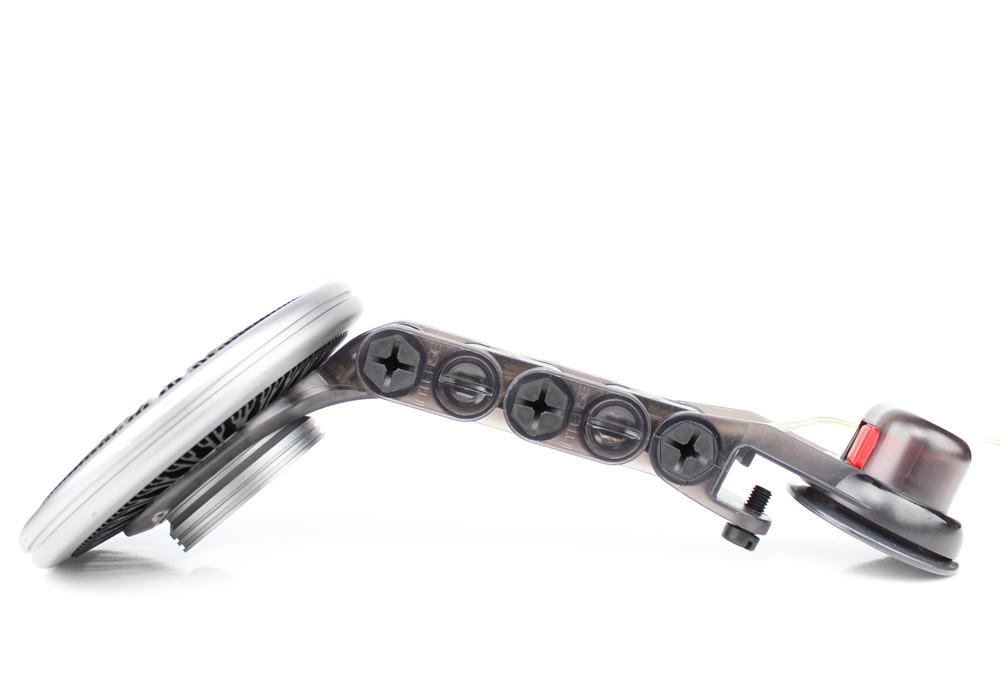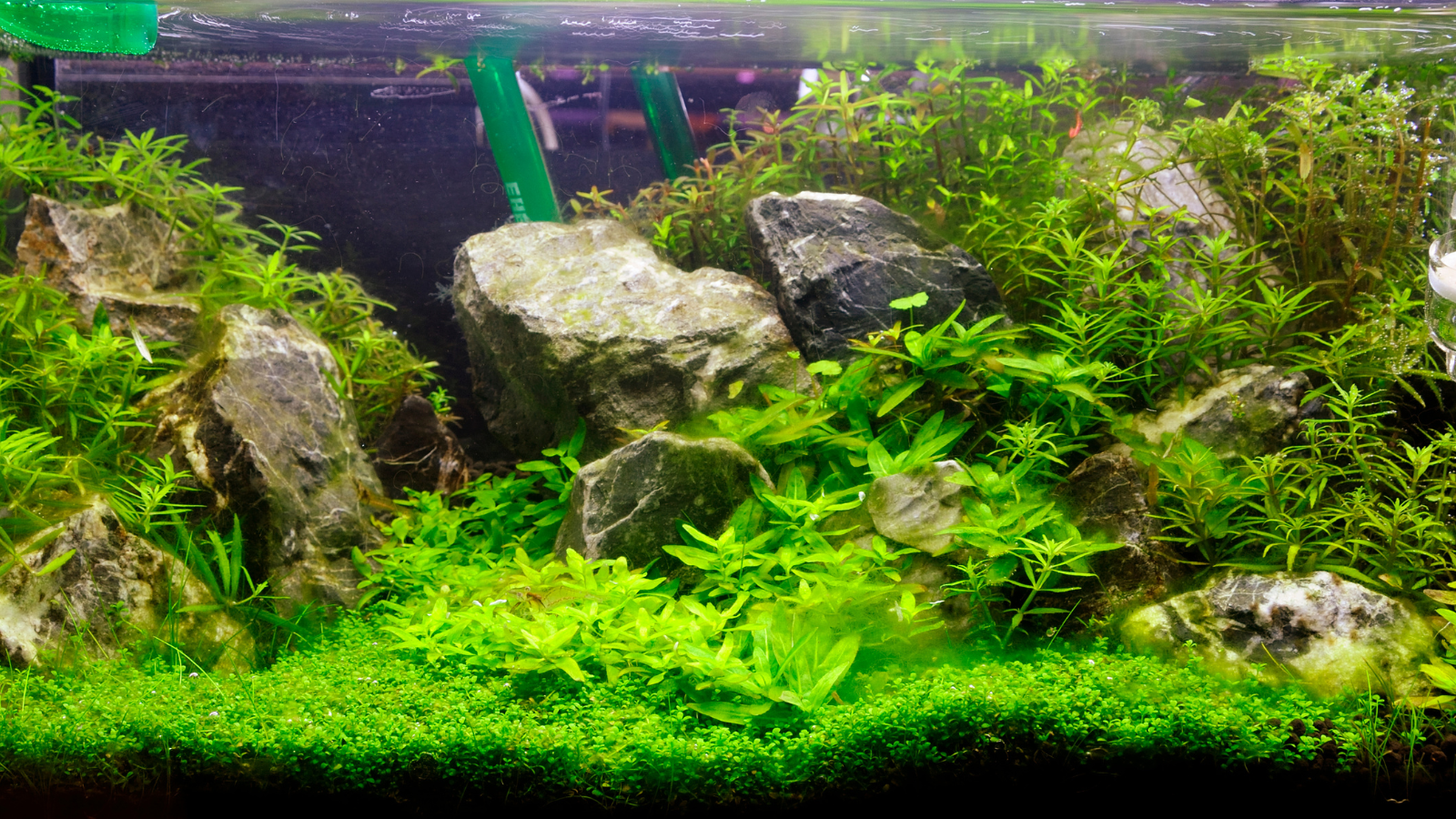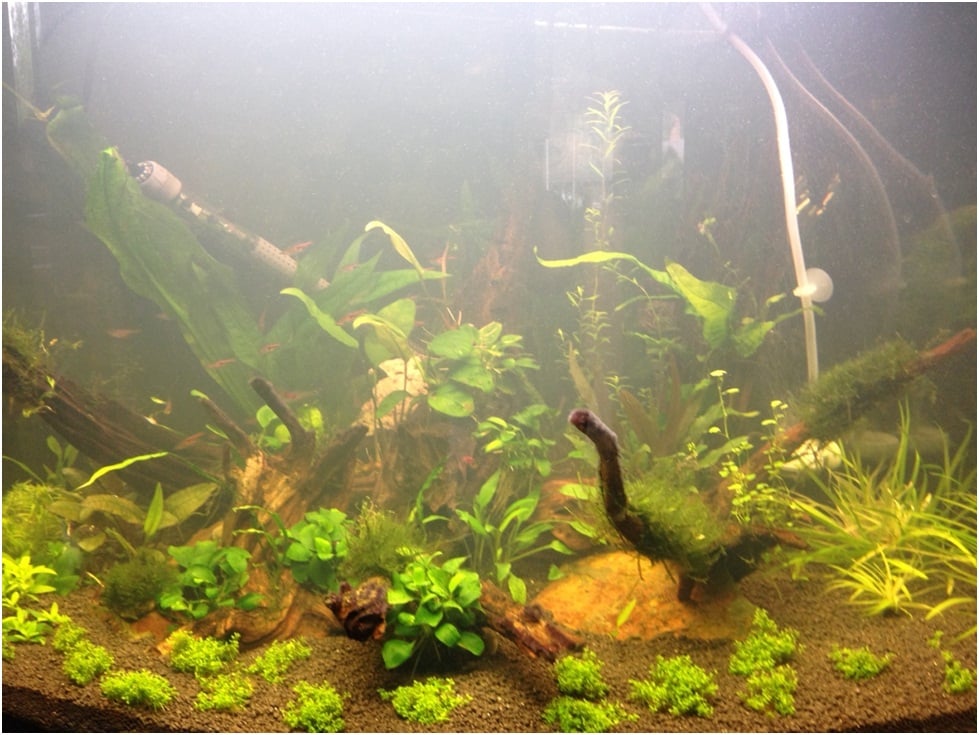
There are many misconceptions regarding the light requirements of a planted aquarium. This causes no end to grief for the hobbyists who follow the so-called rules without understanding some of the fundamental principles of plant physiology and photosynthesis. Hobbyist are typically instructed to use “as much light as possible” or to “upgrade their current poor quality fixtures that came with the tank with brighter, sexier lights”. Unfortunately, most times the end result is an algae ridden tank and/or complete decimation of expensive plants.
Hobbyists have also been taught arbitrary rules such as Watts per Gallon (WPG), and that some plants require higher WPG to flourish. Websites selling plants will often list “Light Requirements” for the species. Another popular arbitrary “rule” states that the optimum Kelvin is 6500K.
None of these “requirements” or arbitrary “rules” have any validity, especially when followed out of context with the CO2 requirements of plants. So for years, hobbyists have been led in circles in vain attempts to provide “optimum” lighting for their plants, while all the time ignoring the most important aspect of plant husbandry. This article is intended to debunk the popular myths about lighting as it relates to plant health.
What is Light and How do Plants Use it?
Hobbyists automatically assume that light shines on the plant and that the plant grow simply as a result of that exposure. We observe, outdoors, for example, that plants in shade do not appear to be as robust as those in full sunshine. The conclusion is that more light is always better, and that if a plant appears unhealthy then it must be due to insufficient light.
The truth is a much more complicated story. Plant leaves actually work in a very similar fashion to a photoelectric diode, where light impinging on the plate causes the material to excite and then to eject electrons. The object within the leaf which contains the electrons is the Chlorophyll molecule.
Light itself is an enigmatic form of energy which behaves as if it were a wave (like an ocean wave) and at the same time, it behaves as if it were a particle, such as a projectile. So for simplicity’s sake it can help to think in terms of a vibrating tuning fork having been shot out of a cannon. When the tuning fork collides with another object it imparts energy not only due to it’s motion as a projectile, but it also imparts the energy of it’s vibration.
Billions of billions of these projectiles, known as “Photons” move across Space. Upon impact with other objects, they are annihilated, but the energy they carried in their vibration is transferred to the object they collided with. If they strike the Chlorophyll at just the right angle and at just the right location, the energy of the Photon is transferred to electrons being held captive by the Chlorophyll. The electrons can then escape and are captured by other proteins which can use the electrons to fabricate other compounds. There may be thousands of individual proteins that capture and then release these electrons in the same way as a line of volunteers move sandbags along the line to build a makeshift dam at the end of the line.
At the end of the line in a leaf, instead of a dam being erected, the electrons are used to remove the Carbon from Carbon Dioxide, to hydrate it with water and the end product is a type of sugar that can easily be turned into glucose. The glucose is used to feed every cell in the entire plant.
Plants grow therefore because of the availability of the food that they are able to make. The light is only one component in this food making process. Water, CO2 and Nutrients such as Phosphate and Nitrate are needed to complete the fabrication of sugar.
Therefore, if we focus only on the light and if we ignore the importance of all the other key ingredients, then sugar cannot be made properly and the plant will starve to death. Imagine the dam builders moving the sandbags from one person to another. Imagine that there are more sandbags than each person can handle. The result will be sandbags dropped, perhaps on the next person’s feet, reducing the efficiency of that person and the next as well. In a very short time, if the number of sandbags increase beyond the ability of each person in the line to handle and to move the bags the result will be chaos. This is exactly what happens in tanks with too much light. Electrons (the sandbags) scatter and damage the entire chain of events.
What is the alternative to WPG and How to Control the Light?
The most fundamental measurement of light energy, if we hold to the projectile analogy, is to simply count the number of projectiles moving across a specified amount of area within a specified amount of time. How many cannon balls strike the wall of a besieged castle per hour? In our case that measurement is called Photosynthetically Active Radiation, commonly known as the acronym PAR.
PAR tells us exactly how many Photon projectiles cross a square centimetre every second. Since the Photon particles are so small and since they move so quickly, the measurement is usually a very large number, somewhere on the order of 1 Billion Billion cannonballs crossing a 1X1 centimetre square every second. This number, a billion billion, is unimaginable, so it’s given an easier name for us to deal with; it’s called a “micromole”. So now it’s easier to talk in terms of 10 micromoles or 20 micromoles instead of something awkward, such as “two point naught times ten to the eighteenth power per centimetre squared, per second”.
In a dark room, turning on a torch reveals that a hand held within the beam, just an inch from the lens is bright, but several feet away, the intensity declines rapidly as the photons spread out to cover more area. If we measure the PAR accurately we’ll find that each time we double the distance from the bulb, the PAR at the doubled distance will be only a quarter of what it was at the first distance. At three times the distance the PAR will have declined to one ninth (1/9th). This falloff is called an “inverse square relationship” and it’s a very useful and consistent rule.
There are reasons why the WPG rule of thumb can cause so much havoc. Firstly, not all light bulb types have the same intensity. A T5 bulb is brighter than a T8 bulb. LED have different wattages and are arranged in different cluster groups making it almost impossible to make any sense of the rule. Secondly, WPG has a very limited scope because of the inverse square rule. In certain tanks, such as a medium size tank, say, 30 gallons or so a given WPG number may be useful, but as the tank size changes, the distance to the bulb on larger or smaller volumes do not change proportionally, so what if the tank size doubles? The vertical distance to the bulb does not double, so the light falloff is not proportional, yet the WPG rule demands a doubling of the wattage. So in large to very large tanks, following the WPG rule can be disastrous.
A much more sensible rule of thumb has been developed using the more consistent PAR measurement. Unfortunately, it’s not a simple rule. PAR measurements have been taken with typical bulb types and the PAR plotted on a graph based on the distance from the bulb. In general terms;
The Low Light zone has been defined as sufficient light to measure less than 50 micromoles at the substrate level.
The Medium Light zone has been defined as sufficient light to measure between 50 and 75 micromoles at the substrate level.
The High Light zone is anything above 75 micromoles measured at the substrate level.
Tanks which have zero CO2 enrichment, i.e. nor gas injection and no liquid carbon dosing would do well to keep to the Low Light zone. CO2 injected tanks should be started in the Low Light zone and after some weeks, if CO2, flow/distribution and nutrition are proven to be adequate, the light can be increased.
What hobbyists need to keep in mind at all times is that there is no relationship between the amount of light and the health of the plant. There are many healthy CO2 injected or liquid carbon tanks using low light. The tank is MUCH easier to maintain and algal blooms are much less prevalent. The consequence of using high light is that the growth rate of plants increase and so does the growth rate of algae. Growth rate is not the same as health. Tanks using high light and poor CO2, or poor nutrition can have plants that grow quickly but which have algae or which have other health problems.
For the novice, beginner, and even for the more experienced, if a tank is purchased as a package deal which includes stock lighting, the absolute worst decision that can be made is to think about “upgrading” the lights. That will always be the beginning of trouble. Hobbyists are encouraged to learn about growing plants using stock lighting or low lighting firsts, regardless of CO2 injection or liquid supplementation. If after gaining some experience, faster growth rates are desired the intensity can be increased, but this always carries the risk of deteriorating plant health if the other components are not attended to FIRST.
What about Kelvin and Spectrum?
Probably the second worst advice given about lighting is that plants require 6500K to be at optimum health. This myth has been around seemingly forever, because of course, the colour temperature of the Sun is about 6000K-6500K so naturally, everyone assumes this must be the perfect “quality” of light. Vendors push “special plant bulbs” at exorbitant prices to unsuspecting hobbyists. If truth be told, few if any aquatic plants ever see full spectrum midday sun, since they grow under the canopy shade and under murky waters in the rain forests of the world, thus rendering the value of Kelvin temperature or of full spectrum moot. Also, no bulb even comes close to the spectral distribution of the sun. Having a few peaks in a few narrow bands does not approximate the sun in any way shape or form. The term "Full Spectrum" is merely another marketing term used to suck people in. If one were to lay out a dozen different bulbs brands, all claiming to be 6500K, they would all appear to be different colors, so no bulb is actually 6500K anyway. When one reads the Kelvin rating on bulbs, the number should be used more as a model number as opposed to having any scientific value.
Fluorescent bulb from the local hardware store grows plants exactly the same as a special plant bulb. There really is no difference in performance assuming that the bulb types are the same and assuming the wattages are the same. Plants automatically make adaptations to their environment by producing pigments that respond to the spectrum that is available. Therefore a bulb purchased from the B&Q, or from Home Depot, or from whatever DIY shop is in the neighbourhood will do exactly the same job, whatever the spectrum is. The difference is that the hobbyist may not like the colour cast of the B&Q bulb. Kelvin ratings and other colour parameters therefore should be considered solely within the context of the emotional impact it has on the viewer. In the same way, for example, in a butcher shop, the bulbs used to illuminate the meat typically have a red component. This makes the meat appear tastier. It’s an illusion, but butchers know this one very well, and they would seldom choose to use a bulb heavy in blue or green, for example, because this would give a negative aesthetic appeal to the meat.
Colours should be used as we would use a paint brush, to paint moods on the tank. If several bulbs are being used, one can simulate morning light with reds and oranges and later in the day switch to bluer tones. It is never necessary to restrict the colours used over the tank in some misguided impression that plants will not do well with any Kelvin value other than 6500K. That is strictly in the realm of fantasy.
What about LEDs?
As LED units become more sensibly priced there will be better availability and more features. DIYers can obtain raw materials and wire their own luminaries. The most important feature in the LED world is the ability to dim the module from 0% to 100% intensity. This is actually a much more valuable feature than how much PAR the unit has, which is usually too high in any case. Dimming allows maximum control, which equates to algae control. Another great feature of the higher end units, and which may filter down into the lower cost units is the availability of multiple colour diodes combined with programmability. As mentioned, this is an artistic feature and as soon as people wake up from their 6500K hypnosis they will realize the true value of colour. Fish and other fauna can be made to appear more colourful. Favourite fluorescent bulbs can be simulated with the right mix of RGB and CYMK.
The question of whether plants can be grow with LED should be obvious by now. Again, more important factors of an LED design is controllability, aesthetics, reliability and so forth.
Lighting Duration (Photoperiod)
Plants rarely require more than about 8 to 9 hours of light. Having a photoperiod any longer than that only encourages algae. It is always best to have a timer for the lights, and if the tank is CO2 injected, there should also be a separate timer for the gas solenoid. Forgetting to turn light off can have dire consequences for the plants.
Photoperiod length should always be considered within the context of intensity. As mentioned earlier in the article, intensity does the damage, therefore, if the intensity is excessive, then the photoperiod has to be strictly curtailed in order to minimize the damage. If the lighting is too low (which almost certainly NEVER happens) then no length of photoperiod can compensate.
If the hobbyist works a late shift, the photoperiod can be shifted in that direction so that viewing is available when he/she is at home. Plants do not care what the actual time of day is, only that the photoperiod is regular and consistent.
Effects of Indirect or Direct Sunlight from Window
This is another area where hobbyists worry more than necessary and misinterpret the observations. In a CO2 injected tank, if CO2, flow, distribution, nutrition and maintenance are adequate, then sunlight falling on the tank has no ill effect. The hobbyist need not take any special precautions due to invasive sunlight. However, if sunlight impinges on the tank and this seemingly results in some type of algae, then this is a strong indicator that there is a more fundamental problem in the tank and that the hobbyist needs to look at the aforementioned factors. The most common problem will be BGA at the bottom of the front glass, perhaps just under the gravel. Black tape can be used to block the light but this is not very artistic. The nitrate levels can be increased to address this.
Do Reflectors Help?
Reflectors on cylindrical tubes, Compact Fluorescents and so forth can increase the PAR output of the fixture. Values range from 10% to 20% depending on configuration, cleanliness and materials. As mentioned, if the tank is suffering too much PAR, then the reflectors are a bad thing and ought to be removed to help the tank recover. If the tank is doing well, then the reflectors can be considered a good thing.
What Are The Signs of Too Much PAR?
Since light intensity drives the need for everything else, the signs of too much light are wide ranging. Too much light causes a demand for more nutrients than is sometimes being delivered. The list of nutrient deficiency is a long one and is covered under a separate article. Too much light causes a demand for more CO2 than is being delivered. This then causes CO2 deficiency which is characterized by melting, falling leaves, deterioration and rotting, black spots, brown spots, curling or other leaf deformation, as well as holes in leaves. CO2 related algae such as Hair or other Filamentous Algae, BBA or other Red Algae. Diatomic Algae can appear after a lighting “upgrade”. It is entirely possible that the lighting is so high that it requires such high levels of CO2 as to be toxic to the fauna.
Is a Siesta a Good Idea?
The Siesta was promoted by a company whose research staff believed that since there were frequent rain showers in the Tropics, which blocked out the sun for a significant period of time during the day, it follows that turning the light off during the middle of the day was good for aquatic plants. As it turns out, there is no demonstrated relationship between plant health and the siesta. In many cases, depending on the other conditions in the tank, plant health worsened, in other cases health improved and in most cases, there is no difference. The distribution of effect essentially means that there were other things happening in the tank which had nothing to do with the siesta.
Is There a Best Bulb or Best Bulb Type?
Yes, the best bulb is the one that makes the tank look the best to you and which does not make life a misery by being over the top with excessive PAR. Everything else can be thrown out the window. Whether it be T5, T6, T8, T12, Halide, LED. Whether it be a Luminaire, hanging lamp, Clip on Arc Pod type. Plants can be grown even with tungsten lighting. They really don’t care. When shopping for lighting, hobbyists are encouraged to first shop for those more important things that will help guarantee success, such as proper levels of flow throughput/filtration, a good CO2 dissolution and distribution plan, a solid nutritional program and frequent water changes and maintenance plan. When all these more important elements are in place, the one can enjoy any type of lighting of any colour and, if care is taken, of any intensity.


